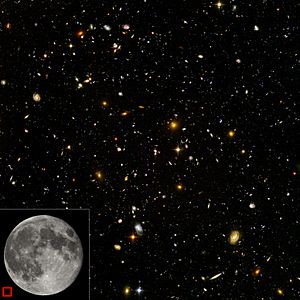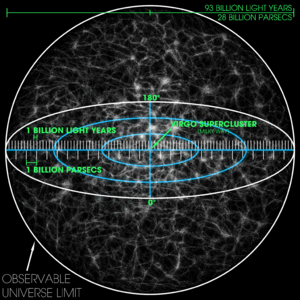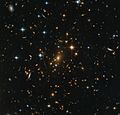Observable universe facts for kids


In Big Bang cosmology, the observable universe is what, in theory, can be seen from Earth. That is light, or other signals, which has had time to reach the Earth since the beginning of the cosmological expansion. The observable universe is a spherical volume (a ball) centered on the observer, regardless of the shape of the universe as a whole. Every place in the universe has its own observable universe, which may or may not overlap with the one centered on Earth.
The word observable does not depend on whether modern technology actually allows detection of radiation from an object in this region. It simply means that it is possible in principle for light or other signals from the object to reach an observer on Earth. In practice, there is much that we cannot see. We can see light only from as far back as when particles were first able to emit photons that were not quickly re-absorbed by other particles. Before then, the universe was filled with a plasma that was opaque to photons.
Sometimes astrophysicists distinguish between the visible universe, which includes only signals emitted since recombination—and the observable universe, which includes signals since the beginning of the cosmological expansion (that is, the end of the inflationary epoch in modern cosmology). The radius of the visible universe, is about 14.0 billion parsecs (about 45.7 billion light years), while the comoving distance to the edge of the observable universe is about 14.3 billion parsecs (about 46.6 billion light years), about 2% larger.
The best estimate of the age of the universe as of 2013 is 13.798 ± 0.037 billion years. Due to the expansion of the universe humans are observing objects that were originally much closer but are now considerably farther away (as defined in terms of cosmological proper distance, which is equal to the comoving distance at the present time) than a static 13.8 billion light-years distance. The diameter of the observable universe is estimated at about 28 billion parsecs (93 billion light-years), putting the edge of the observable universe at about 46–47 billion light-years away.
Gallery
Images for kids
-
Computer simulated image of an area of space more than 50 million light-years across, presenting a possible large-scale distribution of light sources in the universe—precise relative contributions of galaxies and quasars are unclear.
-
"Panoramic view of the entire near-infrared sky reveals the distribution of galaxies beyond the Milky Way. The image is derived from the 2MASS Extended Source Catalog (XSC)—more than 1.5 million galaxies, and the Point Source Catalog (PSC)—nearly 0.5 billion Milky Way stars. The galaxies are color-coded by 'redshift' obtained from the UGC, CfA, Tully NBGC, LCRS, 2dF, 6dFGS, and SDSS surveys (and from various observations compiled by the NASA Extragalactic Database), or photo-metrically deduced from the K band (2.2 μm). Blue are the nearest sources (z < 0.01); green are at moderate distances (0.01 < z < 0.04) and red are the most distant sources that 2MASS resolves (0.04 < z < 0.1). The map is projected with an equal area Aitoff in the Galactic system (Milky Way at center)."
See also
 In Spanish: Universo observable para niños
In Spanish: Universo observable para niños















